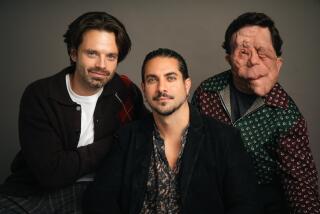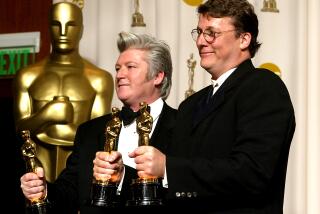Stuart Freeborn dies at 98; âStar Warsâ makeup artist
It was no accident that British makeup artist Stuart Freeborn resembled his most famous movie creation â Yoda, the wrinkled, ancient sage from the âStar Warsâ films.
âI looked at myself in the mirror and decided that I was comic, with all these little knobbles. So I built myself in,â he later said, and added a âhighly intelligentâ flourish by incorporating Albert Einsteinâs furrowed face.
A self-taught wizard of greasepaint and gadgets, Freeborn crafted the diminutive Yoda partly out of wire, electronic circuits and bubbly latex skin. He also devised such âStar Warsâ creatures as Chewbacca and the Ewoks and built Jabba the Hutt out of a blubbery mass of latex.
Freeborn, whose pioneering career spanned seven decades, died Tuesday in London from ailments related to old age. He was 98.
In a statement from LucasFilm confirming Freebornâs death, filmmaker George Lucas said, âStuart was already a makeup legend when he started on âStar Wars.â â
âHe brought with him not only decades of experience, but boundless creative energy,â Lucas said. âHis artistry and craftsmanship will live on forever in the characters he created.â
In the 1960s, Freebornâs skill was showcased in two Stanley Kubrick films. The makeup artist came up with the three faces of Peter Sellers for the satire âDr. Strangeloveâ and the ape-like creatures in âThe Dawn of Manâ sequence for â2001: A Space Odyssey.â
The six months Freeborn expected to spend on â2001â stretched to two years and resulted in groundbreaking innovations. They included a technique that enabled simian-suited actors to use their facial muscles to move their masks.
The film âcatapulted Stuart from âdistinguished artistâ to âdeity,â â Nick Maley, a former makeup assistant, wrote in an online tribute. âIt was the movie that would single him out as a true innovator.â
Michael Key, editor in chief of Make-Up Artist Magazine, called Freeborn âone of the greatest pioneers of movie makeup.â
âHe invented many of the techniques that are standard today,â Key told The Times on Friday. âOne reason for Stuartâs great success was that he was a superb problem-solver.â
Born Sept. 5, 1914, in London, Freeborn was the son of an insurance broker who pressured him to go into insurance. Nurtured by âthrice weekly escapes to the picture palace,â young Stuart aspired to a career in movie makeup, he said last year in a BBC documentary.
At 21, he broke into the movie business by impersonating Ethiopian emperor Haile Selassie.
The Times of London had reported that Selassie had been seen driving a car around London but it was actually Freeborn in makeup, according to Maley. When the escapade received news coverage, Freeborn sent the reports along with photographs of his work to Britainâs newly established Denham Studios, which hired him.
His first on-screen makeup was for 1936âs âWings of the Morning,â the first British film shot in full Technicolor.
When World War II broke out, the newly married Freeborn trained to be a fighter pilot but was waylaid by serious illness. He turned to studying engineering and design, and worked on early radio controls for the military.
After the war, Freeborn gained notoriety, as well as accolades, for his work on the 1948 film âOliver Twist.â
Because producers wanted to remain true to the âcartoon depictionsâ in the book by Charles Dickens, Freeborn designed an exaggerated nose for Sir Alec Guinness, who portrayed the Jewish character Fagin in the film.
The oversized nose led to protests against the movie, and as recently as last year, Freeborn expressed regret that something he created also offended people. He also would mention that he was âpart Jewish.â
While making the 1957 film âThe Bridge on the River Kwai,â Freeborn nearly died when a car in which he and crew members were riding was struck by a truck in Sri Lanka. Thrown from the car, he was the only survivor.
Freebornâs dozens of movie projects including transforming Tony Randall into Hercule Poirot for âThe Alphabet Murdersâ (1965) and concocting fiberglass and foam-rubber dogs covered in fake fur for âThe Omenâ (1976). He also worked on four âSupermanâ films, beginning in 1978.
When a âyoung fellowâ showed up at Freebornâs workplace, Freeborn later said he thought: âHeâs got a lot of nerve.â
He introduced himself as George Lucas and said, âIâve written a script for a film called âStar Wars,ââ Freeborn told the BBC last year. âHe was so genuine, I believed in him. I thought Iâll do what I can for him.â
Freebornâs wife, Kay, and son, Graham, were makeup artists who worked with him on âStar Warsâ and other films. Grahamâs daughter, Michelle Freeborn, also is a makeup artist.
His wife died in 2012. He also outlived Graham and his two other sons, Roger and Ray.
Freeborn is survived by several grandchildren and a number of great-grandchildren.
More to Read
Start your day right
Sign up for Essential California for the L.A. Times biggest news, features and recommendations in your inbox six days a week.
You may occasionally receive promotional content from the Los Angeles Times.







